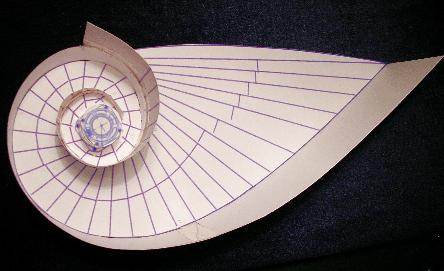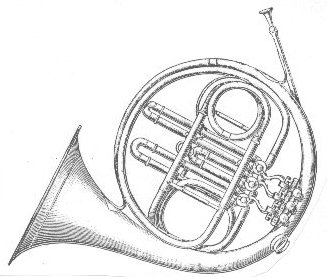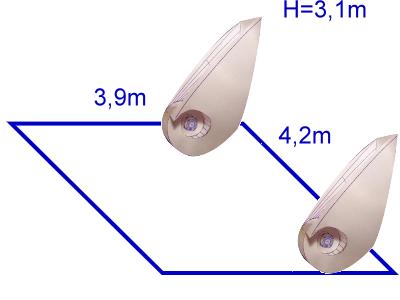Hi Andrew,
Thank you, very nice link: I can read french 😀
I must show this thing I found there, maybe useful to everybody:
With this, a Carfrae little big horn would be a joke.
http://www.neatform.com/
Thank you, very nice link: I can read french 😀
I must show this thing I found there, maybe useful to everybody:
An externally hosted image should be here but it was not working when we last tested it.
With this, a Carfrae little big horn would be a joke.
http://www.neatform.com/
graphic software
Hi Thomas!
Interesting project! 🙂
Could you tell me with which graphic software did you work??
Greets:
Tyimo
Hi Thomas!
Interesting project! 🙂
For my empirical spiral I used an exponential horn formula then turned the contour in a spiral shape with a graphic software.
Could you tell me with which graphic software did you work??
Greets:
Tyimo
Because of lack of maths, and CAD experience, I used an empirical coiling method with something like Photoshop.
First I calculated an exponential horn with this software: http://melhuish.org/audio/exphypcalc.html
You obtain a series of numbers that are the width of mouth each centimeter from the throat to the end of the horn.
I designed one segment with the width of the mouth each 10cm (scaled 1:10 = 1cm) and many segments of 1 cm (scaled) perpendicular to their center, to hold the same distance from each other. Here the result, printed on paper and cut to make a small model scaled 1:10

The problem is to simulate resonances in this 4 meters long horn with 2,5 meters mouth, and the position in the room, to avoid reflections back into the mouth.
Can you help?
Here the data:
Flare freq. : 35 hz
Troath area: 70 cm2 (calculated on Fostex FE206E)
reduction ratio: 4 (2 walls)
Horn lenght: 420 cm.
Mouth area : 15039.37 cm2
Mouth section: 60 X 250 cm
Mouth lenght: 250 cm (~ a quarter wave lenght of 35hz)
First I calculated an exponential horn with this software: http://melhuish.org/audio/exphypcalc.html
You obtain a series of numbers that are the width of mouth each centimeter from the throat to the end of the horn.
I designed one segment with the width of the mouth each 10cm (scaled 1:10 = 1cm) and many segments of 1 cm (scaled) perpendicular to their center, to hold the same distance from each other. Here the result, printed on paper and cut to make a small model scaled 1:10

The problem is to simulate resonances in this 4 meters long horn with 2,5 meters mouth, and the position in the room, to avoid reflections back into the mouth.
Can you help?
Here the data:
Flare freq. : 35 hz
Troath area: 70 cm2 (calculated on Fostex FE206E)
reduction ratio: 4 (2 walls)
Horn lenght: 420 cm.
Mouth area : 15039.37 cm2
Mouth section: 60 X 250 cm
Mouth lenght: 250 cm (~ a quarter wave lenght of 35hz)
Have you tried AJhorn?
Another software Hornresp is also available.
I don't think you will find software that will simulate reflection back into the horn, so we just have to see where you plan to put these speakers and see if there will be a problem. There are a few pointers though:
1. Keep the mouth at least half a wavelength of the lowest frequency away from the walls.
2. If 1. is not possible, then the corners of the room is best rounded with a large radius so that the corners also become part of the horn turning the direction of the horn forward.
Another software Hornresp is also available.
I don't think you will find software that will simulate reflection back into the horn, so we just have to see where you plan to put these speakers and see if there will be a problem. There are a few pointers though:
1. Keep the mouth at least half a wavelength of the lowest frequency away from the walls.
2. If 1. is not possible, then the corners of the room is best rounded with a large radius so that the corners also become part of the horn turning the direction of the horn forward.
Thanks Thomas!
One of the best program for BLH simulating is MJK's Mathcad sheets, but it is without room reflections. So, I have to agree with
soongsc's ideas.
BTW: I think your horn a "bit" too big. 🙂
Greets:
Tyimo
The problem is to simulate resonances in this 4 meters long horn with 2,5 meters mouth, and the position in the room, to avoid reflections back into the mouth.
One of the best program for BLH simulating is MJK's Mathcad sheets, but it is without room reflections. So, I have to agree with
soongsc's ideas.
BTW: I think your horn a "bit" too big. 🙂
Greets:
Tyimo
Martin does actually have the ability to calculate the effect of room boundaries in the latest version of his sheets -rear wall and floor.
Scottmoose said:Martin does actually have the ability to calculate the effect of room boundaries in the latest version of his sheets -rear wall and floor.
By the way the horn mouth and driver are orientated, I think side wall effects are going to be necessary.
Scottmoose said:Martin does actually have the ability to calculate the effect of room boundaries in the latest version of his sheets -rear wall and floor.
Would Martin' mathcad sheets simulate a coiled horn like this?
I would learn to use mathcad before, but if it does....
What do you think about the project?
Tyimo
I'm not so experienced, that's why I've crazy ideas 🙂
Anyway, the horn must not be necessarily so big. You can cut the horn or calculate a different low frequency: with 50hz it's half the lenght.
What I care is only this concept:

As far as I know there are not such horns around. If I find a way, I'd like to build it with round sides.
If you like take a look to www.cornu.de they invented the coiled horn, but with parallel sides to be appended to the wall.
Soongsc,
thanks for the hint! With the mouth diagonally towards the rear wall there are 2 meters. With the mouth diagonally towards the opposite corner in front of the horn, there are 4 m. I could put there a large rounded panel to reflect waves away from the mouth.
I like the idea of a room transformed in a large speaker 🙂
Thomas:
I envy your large room. How large a room are these speakers going in to? Remember you need two of these.
The Mathcad worksheets are actually very easy to work with. From the old versions I tried out, it seems you can define all cross section areas, and add as many cross sections you like by duplicating some lines of equations and changing a few numbers. Since your horn is going to be so smooth, it's pretty close to pulling it into a line.
PS. How far are the horns going to be apart from each other?Will they be gainst the same wall?
I envy your large room. How large a room are these speakers going in to? Remember you need two of these.
The Mathcad worksheets are actually very easy to work with. From the old versions I tried out, it seems you can define all cross section areas, and add as many cross sections you like by duplicating some lines of equations and changing a few numbers. Since your horn is going to be so smooth, it's pretty close to pulling it into a line.
PS. How far are the horns going to be apart from each other?Will they be gainst the same wall?
Not so big. It is 4x4 meters but heigth is 3,1m. Most important, it is reserved to music 😀
Actually, the 4m I said before are a diagonal, maybe are 3,5. I have to draw a 3d plan.
I will look for math-cad sheets, thanks.
Actually, the 4m I said before are a diagonal, maybe are 3,5. I have to draw a 3d plan.
I will look for math-cad sheets, thanks.
thomaseliot said:Not so big. It is 4x4 meters but heigth is 3,1m. Most important, it is reserved to music 😀
Actually, the 4m I said before are a diagonal, maybe are 3,5. I have to draw a 3d plan.
I will look for math-cad sheets, thanks.
Search for MJK member and go to his web site. There are some more explanations there. If you can tell me what your room dimensions are, I can see what SoundEasy comes up with the room modes.
Hi Thomas!
Yes, and it is very interesting!🙂
I think the Hedlund and the Carfrae horns are similar to your idea.
Tha B&W Nautilus (closed TML) is the most similar design.
I am afraid your room is too small for such a big horn.
Greets:
Tyimo
What I care is only this concept
Yes, and it is very interesting!🙂
As far as I know there are not such horns around. If I find a way, I'd like to build it with round sides.
I think the Hedlund and the Carfrae horns are similar to your idea.
Tha B&W Nautilus (closed TML) is the most similar design.
Not so big. It is 4x4 meters but heigth is 3,1m.
I am afraid your room is too small for such a big horn.
Greets:
Tyimo
Thomas,
You have mail.
Based on the size of your room, it seems you may not get as low frequency as you wish because if the horn mouths are in corners, it is much likely that some lower frequency modes will be cancelled.
You have mail.
Based on the size of your room, it seems you may not get as low frequency as you wish because if the horn mouths are in corners, it is much likely that some lower frequency modes will be cancelled.
Hi George,
thank you for the email. What do the colours mean?
Maybe I've to think to smaller enclosures. What would be the lowest frequency possible for the room? All the same I'd like to mantain the same coiled horn design .
Ciao
Thomas
thank you for the email. What do the colours mean?
Maybe I've to think to smaller enclosures. What would be the lowest frequency possible for the room? All the same I'd like to mantain the same coiled horn design .
Ciao
Thomas
KimBOlesen said:Hi
Why do you want the horn mouth to be 1/4 wave lengt ?
Best regards
Kim Olesen
Hi Kim,
I read somewhere that this is required to reproduce really the desired lowest frequency. I expected some discussion on this point.
thomaseliot said:Hi George,
thank you for the email. What do the colours mean?
Maybe I've to think to smaller enclosures. What would be the lowest frequency possible for the room? All the same I'd like to mantain the same coiled horn design .
Ciao
Thomas
Think of the colors as peaks and null of a sine wave. Geen mean null, red and blue are the positive and negative peaks. The peaks could be reversed in color depending on the actual location of the exictation source.
Thomas,
I think it's necessary to look through the room modes to determine speaker placement first. Normally if your speakers are very well balanced, then you want to place them as close to most of the null locations as possible. If you want to enhance a specific frequency, you could look and see where the peaks at those frequencies are and enhance them by placing at the peaks. Avoid placing one speaker at a red peak and another at a blue peak unless you want to null that frequency. But it's necessary to simulate the speakers first to see how they perform.
If your driver is more 40cm away from the horn mouth, you probably need to consider the difference in location as well.
I think it's necessary to look through the room modes to determine speaker placement first. Normally if your speakers are very well balanced, then you want to place them as close to most of the null locations as possible. If you want to enhance a specific frequency, you could look and see where the peaks at those frequencies are and enhance them by placing at the peaks. Avoid placing one speaker at a red peak and another at a blue peak unless you want to null that frequency. But it's necessary to simulate the speakers first to see how they perform.
If your driver is more 40cm away from the horn mouth, you probably need to consider the difference in location as well.
Hi Guys,
The length of a 1/4 wavelength for one side of the mouth is correct for
a full size horn. This is required to get the resistance matching to the air. I have a chart and formula for horn design. It includes expansion rates for a given cutoff.
If you think it could be useful I can scan and email.
If the horn is in a corner, the walls can become part of the horn,
a la Klipsch.
Regards,
Geoff
The length of a 1/4 wavelength for one side of the mouth is correct for
a full size horn. This is required to get the resistance matching to the air. I have a chart and formula for horn design. It includes expansion rates for a given cutoff.
If you think it could be useful I can scan and email.
If the horn is in a corner, the walls can become part of the horn,
a la Klipsch.
Regards,
Geoff
- Status
- Not open for further replies.
- Home
- Loudspeakers
- Full Range
- Back loaded big spiral horn with Fostex FE206E
